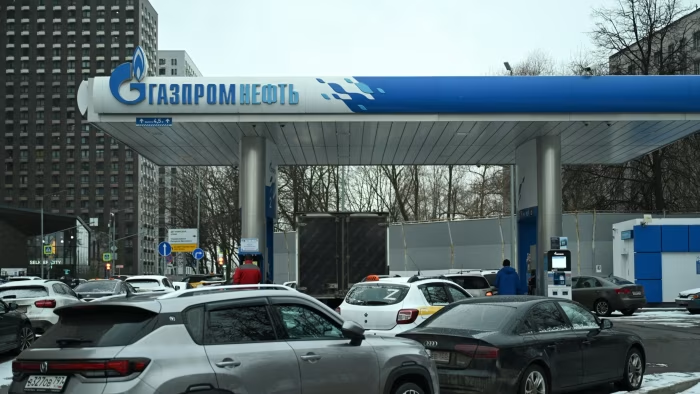Wholesale petrol prices in Russia have hit record highs this week and the fuel is in short supply in several regions as a result of Ukrainian drone strikes on refineries.
The crisis prompted Moscow last week to suspend exports of petrol so that it could keep refined products for the domestic market.
A regular seasonal price rise that began in the early summer accelerated sharply this month, and wholesale prices first broke the September 2023 record on August 4.
Prices on Russia’s most common petrol grade (A95 or Euro 95) reached Rbs82,300 ($1,023) a tonne on Wednesday on the St Petersburg exchange, up 55 per cent since the start of the year and 8 per cent since the beginning of August.
The disruption to the petrol market underscores that while Moscow is claiming the upper hand on the battlefield in Ukraine and still can fund the invasion it launched in 2022, it does face tangible economic impacts at home.
Since early July, Ukraine has struck at least four major oil refineries in Russia, according to Kyiv. While such attacks are not unprecedented, they have grown more frequent in recent months. The latest Ukrainian drone strike came on Thursday, with an attack on Novoshakhtinsk refinery in southern Russia, which produces around 5mn tonnes of refined products a year, most of which it normally exports.
“In 2024, the attacks were numerous but scattered, usually limited to a single refinery at a time, and the damage was typically repaired fairly quickly,” said Sergey Vakulenko, a senior fellow at the Carnegie Endowment for International Peace.
The current campaign, he added, is aimed at all the plants in a key consumption and refining region, and could put them out of operation for a long time or “even permanently”.
Russia’s oil industry was one of the main targets of Ukrainian long-range attacks, Ukrainian Security Service (SBU) head Vasyl Malyuk confirmed earlier in August.
Sergei Kaufman, an analyst at Moscow-based brokerage Finam, estimated at least 10 per cent of Russia’s refining capacity was disrupted.
The situation is further complicated by Ukrainian attacks on railway infrastructure in central Russia, which have led to frequent delays in train services — something not seen in decades — and disrupted freight trains carrying fuel.
Disruptions to train and air travel caused by the attacks have also pushed more people to use cars, adding further pressure on demand.
To rein in the soaring prices caused by these attacks, the Russian authorities banned all petrol exports on July 28, tightening previous, partial restrictions on some of the trade.
The measure boosted domestic shipments by 150,000 tonnes this month but fell short of containing price growth, said David Martirosyan, an analyst at the Russian Price Index Centre. “This points to a partial supply deficit on the domestic market,” he added.
“Even with the export ban in place, domestic demand is not being fully met,” said Finam’s Kaufman. “And the lack of published stockpile statistics adds to market anxiety.”
Russian authorities barred the release of such data last May amid Ukraine’s attacks, citing the need to prevent “market manipulation in light of the geopolitical situation”.
But even without access to official data, Russians can see that the fuel situation is worsening. While retail prices have risen more slowly than wholesale ones thanks to state financial support for oil companies in the domestic market — as well as an unspoken ban on sharp price rises — the increases have still been steep.
Retail petrol prices in Russia have risen 9 per cent over the past year and more than 5 per cent since January, outpacing average inflation. The price increases and the shortages vary across regions and fuel stations, with the most acute shortages in areas far from the country’s centre.
“What’s this madness with petrol? Did we suddenly get rich?!” asked Alexei, a user in a local chat in Chita, a city in the eastern Zabaykalsky region bordering Mongolia where shortages of A95 have been among the most acute.
At some stations in the region, fuel is being rationed through “coupons” issued to organisations, local media reported — a practice that for many Russians evokes memories of the late Soviet era.
Russia-annexed Crimea has also run out of this petrol grade. “Unfortunately, there are disruptions at some petrol stations in Crimea,” wrote Sergei Aksyonov, the head of Crimea appointed by Moscow, on his Telegram channel. He attributed this to “both reduced production volumes and logistics”.
Most private cars in Russia run on petrol, with less than 10 per cent fuelled by diesel, data from the Autostat analytics agency shows.
Analysts expect the prices to keep rising at least through September, and shortages to continue in regions hard to supply logistically, but do not anticipate an overall national shortage, because seasonal summer demand from drivers will ease and some of the damaged refining capacity can be restored.
But Ukraine seems to have a different plan in mind. “More to come,” Ukraine’s general staff said in a statement confirming the most recent strike on the Syzran oil refinery in Russia’s central Samara region on August 15.
“The consumer market may face an unprecedented level of problems,” said Carnegie’s Vakulenko. He and other analysts suggest Russia may resort to increased imports of petroleum products from Belarus, which refines them from Russian crude.
But a systemic crisis is still a long way off, since large vehicles and military equipment run on diesel, which is not in short supply. “A full-scale fuel supply crunch — one affecting the army, transport and agriculture, and capable of disrupting the economy — is still distant,” Vakulenko added.
https://www.ft.com/content/1a22515d-f0e2-4f11-8e1f-6d7b9d30ef13



